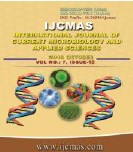


 National Academy of Agricultural Sciences (NAAS)
National Academy of Agricultural Sciences (NAAS)

|
PRINT ISSN : 2319-7692
Online ISSN : 2319-7706 Issues : 12 per year Publisher : Excellent Publishers Email : editorijcmas@gmail.com / submit@ijcmas.com Editor-in-chief: Dr.M.Prakash Index Copernicus ICV 2018: 95.39 NAAS RATING 2020: 5.38 |
Hepatitis B virus (HBV) is a DNA virus belonging to the Hepadnaviridae family that infect humans causing a disease infecting liver cells displaying a substantial hepatic tissue tropism, and inducing chronic liver damage and subsequent Hepato carcinogenesis. In Oncology patients receive packed red blood cell suspensions and other blood products regularly and they are in the high-risk group for infections due to these viruses. In addition to Hepatocellular carcinoma several studies have proved the existence of HBV in some extra hepatic organs and tissues, such as the kidneys, skin, lymph nodes, bone marrow, vessel walls, colon, pancreas as well as stomach. Chemotherapy, which is one of the main modality of treatment for cancer not only suppresses the immune system which cause an increment in HBV DNA (viral load) and damage the liver. In clinical practice, the oncologists deal with a large number of patients undergoing anticancer treatments and both patients and clinicians are unaware about patient infection with HBV thus posing a serious threat to health care professionals and society at large and HBV infection in these cancer patients can results in life-threatening events and poor outcome due to early discontinuation of Chemotherapy. Aims of the study are to study the geographical and demographic profile like age groups and gender, urban or rural in patients coming in tertiary care cancer hospital in Bathinda; To study the prevalence of HBsAg in cancer patients. To study the screening of HBV infection in cancer patients; To examine sex specific factors associated with being unaware of one’s HBsAg Seropositivity status. This descriptive study was carried out in a teaching cancer hospital in Bathinda (Punjab), India. Demographic and geographical data of the hepatitis B patients admitted to our hospital was collected for a period of 2 year from 1.5.16 to 31.8.18. Patients of all age groups with positive anti-HBV by enzyme immune assay for the detection of anti-HBV antibodies by using fourth generation kits were included. In total, 1096 patients had undergone hepatitis B serology test. Hepatitis B infection was positive in 31 patients (2.8%). HBsAg frequency reported was 8.2% in rural areas and 6.2% in urban areas. No significant association was observed between types of cancers and HBsAg positivity. Our study could be used an early opportunity to direct efforts towards creating awareness among different sections of the community regarding all aspects of the disease in order to keep further transmission of this infection at check and also screening for HBV is must be made mandatory before administration of chemotherapy and prophylactic antiviral therapy. Stringent policies and strategies should be implemented to increase the public’s awareness of their HBV infection status, particularly to be targeted are females with a low socioeconomic status this will not only reduce the incidence of HBV reactivation but also HBV-related morbidity and mortality.
 |
 |
 |
 |
 |